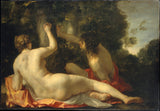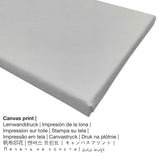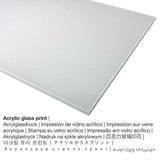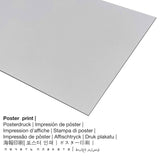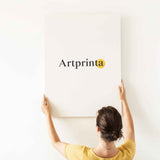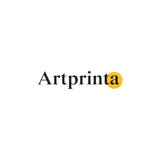Jacques Blanchard, 1630 - Angelica na Medoro - mbipụta nka mara mma
Ụtụ gụnyere. Mbupu gbakọrọ na ndenye ọpụpụ.
Nchịkọta nke oyiri
a 17th narị afọ ihe nka akpọrọ Angelica na Medoro was painted by the baroque painter Jacques Blanchard. The painting was made with the absolute size - With added strip at top 47 7/8 x 69 1/4 in (121,6 x 175,9 cm) and was manufactured with the Usoro of mmanụ na kwaaji. Taa, artpiece dị na Ụlọ ihe ngosi nka nke Metropolitan digital art collection, nke bụ otu n'ime ụwa kasị na kasị mma art ngosi nka, nke na-agụnye ihe karịrị nde abụọ ọrụ nka nke gbasara puku afọ ise nke omenala ụwa, site na prehistory ruo ugbu a na site n'akụkụ ọ bụla nke ụwa .. Site n'ikike nke ụwa. Ụlọ ihe ngosi nka nke Metropolitan, New York, Onyinye George A. Hearn, 1906 (ọha na eze). Additionally, the artpiece has the creditline: Gift of George A. Hearn, 1906. In addition to this, the alignment is landscape with a side ratio of 1.4: 1, nke pụtara na ogologo bụ 40% ogologo karịa obosara. Jacques Blanchard was a male painter from France, whose artistic style was mainly Baroque. The European painter was born in the year 1600 na Paris, Ile-de-France, France ma nwụọ mgbe ọ dị afọ 38 n'afọ 1638.
Họrọ nhọrọ ihe
Maka ngwaahịa ọ bụla anyị na-enye nha na ihe dị iche iche. Anyị na-ahapụ gị ka ịhọrọ n'ime ụdị ndị a:
- Akwụkwọ mmado ebipụtara (akwa akwa akwa): The poster is a UV printed canvas with a slightly roughened structure on the surface. Please note, that depending on the size of the poster we add a white margin of around 2-6 cm round about the painting, which facilitates the framing with your custom frame.
- Mbipụta kanvas: A printed canvas, not to be mistaken with a canvas painting, is a digital copy applied on a canvas. What is more, canvas makes a cosy and pleasant atmosphere. Canvas prints are relatively low in weight, which means that it is easy and straightforward to hang the Canvas print without the support of any wall-mounts. A canvas print is suitable for all types of walls.
- Mbipụta ọla (aluminium dibbond): Aluminium Dibond prints are metal prints with an outstanding depth. Its non-reflective surface make a fashionable look. A direct Aluminium Dibond Print is the ideal introduction to fine reproductions manufactured with aluminum. For your Print On Aluminum Dibond, we print the favorite artwork on the aluminium composite surface. The bright parts of the original artwork shine with a silky gloss, however without any glow. The colors of the print are luminous and bright in the highest definition, the fine details appear clear and crisp. This direct print on aluminium is one of the most demanded entry-level products and is an extremely stylish way to display artworks, as it puts the viewer’s attention on the artwork.
- Mbipụta enyo acrylic: An acrylic glass print, which is sometimes named as a UV print on plexiglass, will change the original work of art into beautiful wall décor. Above all, it makes a good alternative option to aluminium and canvas prints. The work of art is being custom-made with modern UV print technology. The acrylic glass protects your selected fine art print against light and external influences for many years to come.
Legal disclaimer: We try our best in order to depict the products in as much detail as possible and to illustrate them visually. Nonetheless, the tone of the printing material, as well as the print result can diverge to a certain extent from the representation on the device's monitor. Depending on the settings of your screen and the nature of the surface, not all colors are printed as realistically as the digital version. Given that our fine art prints are printed and processed by hand, there may also be slight differences in the motif's exact position and the size.
Nkọwapụta ngwaahịa
| Nkewa ngwaahịa: | mmepụta nka |
| Usoro mmeghari: | mmeputakwa n'ụdị dijitalụ |
| Usoro mmepụta: | mbipụta dijitalụ |
| Ihe ngosi: | emere na Germany |
| Ụdị ngwaahịa: | a na-achọ |
| Ngwaahịa were: | ihe ndozi ụlọ, gallery mgbidi |
| Ndepụta: | nhazi odida obodo |
| Ụdị anya: | 1.4: 1 (ogologo: obosara) |
| Oke onyonyo pụtara: | ogologo bụ 40% ogologo karịa obosara |
| Akụrụngwa ị nwere ike ịhọrọ site na: | akwụkwọ mmado (akwụkwọ kwaaji), mbipụta ọla (aluminium dibond), mbipụta kanvas, mbipụta iko acrylic (nwere ezigbo mkpuchi iko) |
| Mbipụta kanvas (akwa akwa n'elu etiti ihe ndọtị) ụdị nha dị iche iche: | 70x50cm - 28x20", 140x100cm - 55x39" |
| Mbipụta iko acrylic (nke nwere ezigbo mkpuchi iko): | 70x50cm - 28x20", 140x100cm - 55x39" |
| Nhọrọ nke mbipụta akwụkwọ mmado (akwụkwọ kwaaji): | 70x50cm - 28x20" |
| Nha ebipụta aluminom: | 70x50cm - 28x20", 140x100cm - 55x39" |
| ụba: | biko buru n'uche na mbiputa nka enweghi okpokolo agba |
Ozi ndabere na nka pụrụ iche
| Aha eserese ahụ: | "Angelica na Medoro" |
| Nhazi nka: | sere |
| Okwu mkpokọta: | nka ochie |
| oge: | 17th narị afọ |
| Afọ okike: | 1630 |
| Afọ nka: | karịa afọ 390 |
| Usoro nka izizi: | mmanụ na kwaaji |
| Akụkụ ihe osise izizi: | With added strip at top 47 7/8 x 69 1/4 in (121,6 x 175,9 cm) |
| Egosiputara na: | Museumlọ ihe ngosi nka nke Obodo |
| Ebe ebe ngosi nka: | New York City, New York, Njikota Obodo Amerika |
| URL webụ: | Museumlọ ihe ngosi nka nke Obodo |
| Licensedị ikike: | ngalaba ọha |
| Site n'aka: | Ụlọ ihe ngosi nka nke Metropolitan, New York, Onyinye George A. Hearn, 1906 |
| Ebe E Si Nweta: | Onyinye nke George A. Hearn, 1906 |
Data omenka ahaziri ahazi
| aha: | Jacques Blanchard |
| Aliases: | Blanchard Jacques I, Jacques Blanchart, Jaques Blanchard, Monsr. Blanchart, M. Blanchard, Sr. Blanchard, Jacques Blanchard, J. Blanchard, Jacques I Blanchard, Blanchart, Monsieur Blanchart, Blanchard Jacques, Mr. Blanchart |
| okike onye nka: | nwoke |
| Obodo onye nka: | French |
| Ọrụ: | onye na-ese ihe |
| Obodo onye nka: | France |
| Nkewa onye nka: | nna ukwu ochie |
| Ụdị nke onye na-ese ihe: | Baroque |
| Nwụrụ anwụ: | 38 afọ |
| Afọ ọmụmụ: | 1600 |
| Ebe omuma: | Paris, Ile-de-France, France |
| Afọ ọnwụ: | 1638 |
| Nwụrụ na (ebe): | Paris, Ile-de-France, France |
Enwere ikike nwebiisinka ©, Artprinta.com (Artprinta)
Nkọwa ndị ọzọ site na ihe ngosi nka (© - Ụlọ ihe ngosi nka nke obodo ukwu - www.metmuseum.org)
The canvas illustrates a passage from Ludovico Ariosto's (1474–1533) epic poem Orlando Furioso (XIX:36), in which the two lovers engrave their names in the bark of a tree. Because the surface is worn, the letters are no longer visible. In the early 1630s Blanchard was decorating the galleries of various private houses in Paris with such narrative pictures in series. The soft lighting and languid nudity suggest the influence of sixteenth-century Venetian painting.

